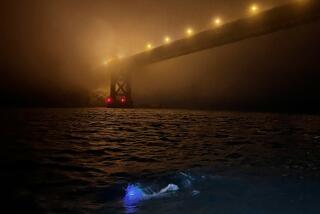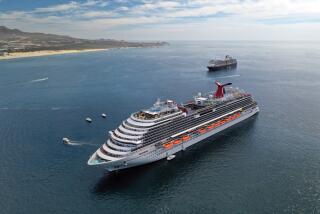British Warship Sails to Her Rescue
- Share via
Karen Thorndike was alone in the angriest of seas, practically delirious with flu, suffering from extreme exhaustion, dehydration and chest pains so severe she wondered how much longer she could last.
The winds had built to 60 knots-plus. The ocean had become mountainous; waves were
sweeping her 36-foot sailboat, which had become nearly impossible to steer and, even with sails down, was drifting at a speed of nearly 10 knots.
Thorndike was more than 300 miles northeast of the Falkland Islands, but might as well have been in the middle of the South Atlantic. Reaching Perth, Australia, about 7,700 miles away, had become the farthest thing from her mind, as had becoming the first American woman to solo-circumnavigate the globe.
Thorndike was hoping merely to survive. A distress signal had been sent the previous day. Help was on its way, but would it get there in time?
It was as Thorndike, drenched and trembling from cold and fatigue, was pondering this question that her savior emerged dramatically through the mist, in the form of the hulking British frigate, HMS Norfolk.
So impressed by the sight of this 340-foot warship was the intrepid sailor from Seattle that she could only exclaim, “Oh, my God!”
Cmdr. Peter Hudson dispatched a crew of four to pick up Thorndike, put four sailors aboard her boat, Amelia, with orders to sail it back to Port Stanley in the Falklands. Hudson then put Thorndike under the care of the ship’s doctor and steamed ahead, arriving at the Falklands 24 hours later, at about 11 a.m. last Tuesday.
Thorndike, 52, was kept overnight for observations at King Edward VII Memorial Hospital in Port Stanley and released at 5 p.m. Wednesday. Doctors in the remote British island colony were unable to determine the cause of the chest pains and advised her to return home for further tests before continuing her journey.
Thorndike, who set sail last August from San Diego on an attempted circumnavigation that was supposed to end in July, said she will take that advice and has put on hold indefinitely her plans to make sailing history.
“I don’t know for sure what’s wrong,” she said. “They are telling me that the medical resources in the Falkland Islands are limited, and they are not able to diagnose the cause of the problems. I definitely want to continue. It’s just a matter of when. Obviously, I have to solve my medical problems first.”
*
Thorndike’s rescue is being called miraculous by her support team in Seattle. Were it not for the satellite technology aboard her boat, and the proximity of the HMS Norfolk, only 250 miles away, she might very well have joined the long list of explorers sent to watery graves by violent seas.
A flu epidemic had hit the small community of Port Stanley in the days before Thorndike set sail on the fifth leg of her journey. She began to feel the effects of the virus the day after she left.
Not long after Thorndike left, a light wind began to grow stronger and stronger. Amelia was pelted by sleet and hail. Thorndike pressed on, steering at times by hand, but also using a mechanism that enables her to lock the steering device in a fixed position.
Fortunately, she was able to remain in regular contact with her home base via e-mail.
Her situation began to worsen last Sunday morning. She informed John Oman in Seattle, “I did not expect it would be this difficult to get away from the Falklands and certainly did not expect to leave with the flu. . . . The expected 35 knots from the east came through last night. . . . It was pretty intense with hard rain squalls and lightning. . . .”
Several hours later, at 1:39 Falklands time, she sent another e-mail: “John, I have 50 knots right now and we are going to see more. The waves are sweeping us and I think the self-steering can’t cope. Latitude 47-46. Longitude 58-15. Gotta go.”
It was at this point that Thorndike began experiencing chest pains, which on top of everything else began to overwhelm her. “At one point I thought I was having a heart attack,” she would say later. “The pain in my chest was terrible. Topped off with major fatigue I felt it was impossible to cope any longer. “
At 2:59 she pushed the emergency satellite distress signal, which was picked up by the Royal Navy, and she informed Oman via e-mail, “John, need medical help.”
Oman began scrambling to contact authorities on the Falklands, but the phones were down because of the weather. The only communication was by military satellite from London to the Royal Navy, which was equipped with an Inmarsat “A” satellite voice communication system.
The HMS Norfolk was 50 miles from the Falklands and ordered to launch a rescue attempt. Hudson estimated that he wouldn’t be able to reach Thorndike until 6:30 Monday morning.
Thorndike, fighting to keep Amelia from being capsized by waves that were now broadsiding her, managed to e-mail Oman every two hours with her position. Oman, put in phone contact with the HMS Norfolk, relayed Thorndike’s position. It was this ability to communicate that probably saved Thorndike’s life.
By 6:30 Monday morning, the HMS Norfolk had picked up Amelia on its radar screen and within minutes was at her side. “She was suffering from quite a severe bout of angina and also quite severe flu and was particularly unwell,” Hudson told the British Naval control in the Falklands. “She was suffering from dehydration, tiredness and shock.”
Thorndike said she will have to get an extensive assessment of her health before deciding whether to continue her journey. What bothered her most, she said, was that others were asked to risk their lives to save hers.
“Very careful consideration should be given in taking this kind of action and putting others at risk,” she said. “But should that unfortunate situation occur again . . . I would highly recommend being close to a British Navy vessel.”
BAJA BITE
What a week it has been for marlin fishermen off Cabo San Lucas. “Horrendous,” says Jeff Klassen of Los Cabos Fising Center. “Baffling,” adds Tracy Ehrenberg of the Pisces Fleet. The culprit: cool, green water.
“You have to go at least 15 miles out to find blue water,” Klassen says, adding that even then there are no guarantees as both baitfish and billfish remain scattered. The good news is, dorado don’t seem to mind the green water, and that the mightiest billfish of them all--the broadbill swordfish--is in the area, though in small numbers. Largest of the week, a 276-pounder caught aboard Baja Roo.
San Jose Del Cabo: Same story. Green water extends 20 miles out into the gulf. Beyond that, however, at an area between Gordo Banks and the Cabrilla Seamount, both marlin and dorado are feeding heartily, according to Victor Gutierrez of Victor’s Pangas. This is being targeted by fleets from Cabo as well, despite the two-hour-plus boat ride.
East Cape/La Paz: With seasonal north winds raging across the gulf, attention is focused on the protected waters surrounding the islands. David Jones of Fishermen’s Fleet says pargo, or mullet snapper, are their usual ferocious selves at Cerralvo Island, easy to hook but difficult to pull from their rocky caverns. When the wind doesn’t blow, the boats are able to get offshore where, you guessed it, cool green water is prevalent. Still, reports Ronnie Kovach of Eagle Claw Fishing Schools, if you can persuade your skipper to venture offshore “there is wall-to-wall dorado, with a lot of tuna mixed in.”
MISCELLANY
Boating: Things are sailing right along for retailers at the Southern California Boat Show, which runs through Sunday at the Los Angeles Convention Center. In the show’s first hour, a 42-foot Sea Ray sold for $350,000, and Sun Country Marine reported sales of 35 boats in the first week. Personal watercraft such as Jet Skis, Sea-Doos and Wave Runners remain the hottest items, however. . . . Hunting: The U.S. Fish and Wildlife Service on Wednesday gave final approval to the use of bismuth-tin shot for waterfowl hunting after tests showed it is nontoxic when ingested by ducks and geese. . . . Whale watching: The Week of the Whale, a nine-day festival that includes daily lectures, slide shows, children’s programs and guided whale-watching trips, begins Saturday in Santa Barbara. The event is co-sponsored by the Santa Barbara Museum of Natural History and Channel Islands National Marine Sanctuary and designed “to educate the public about Santa Barbara’s natural treasures, such as 28 species of whales and dolphins that travel through, live and breed in [sanctuary waters].” Details: (805) 966-7107.
More to Read
Sign up for Essential California
The most important California stories and recommendations in your inbox every morning.
You may occasionally receive promotional content from the Los Angeles Times.










